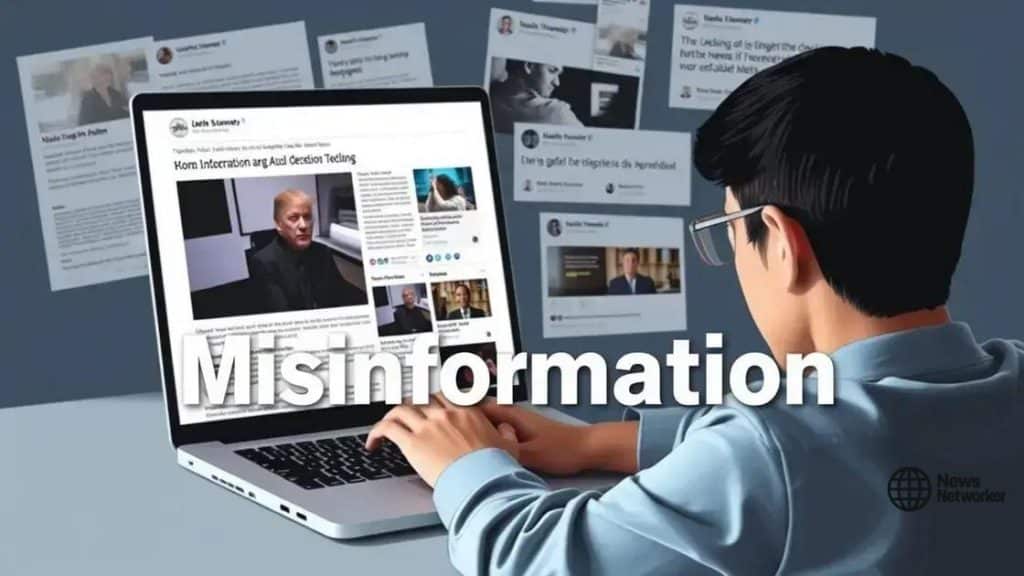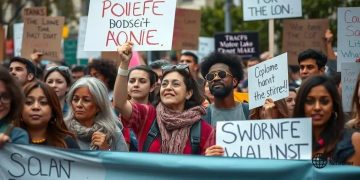Combating misinformation and fake news: a guide

Combating misinformation and fake news requires community engagement, utilizing workshops, social media campaigns, and fact-checking resources to educate individuals and promote critical thinking about the information they encounter.
Combating misinformation and fake news has become a crucial challenge in our digital age. With the rapid spread of information, discerning what is true or false can be overwhelming. How do we navigate this complex landscape?
Understanding the roots of misinformation
Understanding the roots of misinformation is crucial in today’s information-rich society. When people encounter false information, it can lead to confusion and distrust. To tackle this issue, we must first understand where misinformation comes from.
Common Sources of Misinformation
Several factors contribute to the spread of misinformation. Some of the most common sources include:
- Social media platforms, where content can quickly go viral.
- Misleading headlines that capture attention but provide inaccurate information.
- Pseudoscience and unreliable sources that lack credibility.
Each of these sources plays a role in disseminating false information, often with significant repercussions.
Psychological Factors
Understanding misinformation also involves the psychological aspects of how people process information. People are naturally inclined to believe information that aligns with their existing beliefs. This phenomenon, known as confirmation bias, can lead to the spread of misinformation among like-minded individuals.
Additionally, emotional responses can cloud judgment. When people encounter information that evokes strong emotions, they might overlook the facts and share without verifying. This is why sensational stories often gain traction, emphasizing the need for critical thinking.
Promoting media literacy is essential to combat misinformation. Teaching individuals to analyze information sources critically can significantly reduce the impact of fake news. Encouraging questioning of sources and verifying facts allows readers to make more informed decisions.
Formation of Echo Chambers
In the age of social media, echo chambers—where people are exposed only to information that confirms their beliefs—are increasingly common. Within these isolated communities, misinformation thrives, as members share and reinforce false narratives without external scrutiny.
Combating misinformation requires a multi-faceted approach. As individuals, we must strive to engage with diverse viewpoints and challenge our perspectives. This awareness can mitigate the effects of misinformation and foster a more informed society.
The impact of fake news on society
The impact of fake news on society is profound and far-reaching. Every day, people are exposed to misleading information that can shape opinions and influence decisions. Understanding this impact is crucial for fostering a well-informed public.
Effects on Public Opinion
Fake news can significantly alter public opinion. When false information spreads, it can create misconceptions about important issues. For instance, during elections, fake news can unfairly sway voters by misrepresenting candidates and their policies.
- Increased polarization among different groups.
- Distortion of facts leading to misguided beliefs.
- Manipulation of emotions, causing public outrage.
Such effects can sow division within communities, making constructive dialogue challenging.
Public Trust Erosion
Another major consequence is the erosion of trust in traditional media and institutions. When reputable news sources are undermined by fake news, people may become skeptical of all news. This skepticism can lead to a reliance on alternative sources that may not provide accurate information.
This decline in trust can have lasting effects on democracy. Informed citizens are essential for a functioning democracy, and when trust is lost, participation can diminish.
Real-World Consequences
The ramifications of fake news extend beyond opinions and trust. Misinformation can lead to tangible repercussions, even putting lives at risk. For example, false health information can result in people ignoring vital medical advice.
Furthermore, fake news can incite violence by promoting harmful narratives. In extreme cases, this has led to real-world conflicts and divisive protests, showing just how dangerous misinformation can be.
Addressing the impact of fake news on society requires collective action. By fostering critical thinking and media literacy, individuals can empower themselves and others to spot misinformation.
Techniques for identifying false information

Identifying false information is essential in today’s digital landscape. With the constant flow of content online, techniques for identifying false information have become vital for individuals seeking the truth.
Check the Source
The first step is to verify the source of the information. Reputable organizations typically have established credibility. Look for:
- Well-known news outlets with a strong track record.
- Authors with relevant qualifications or expertise.
- Transparency about their editorial standards.
By confirming the source, you can avoid sharing misleading content.
Cross-Verify Information
Another effective technique is to cross-verify information with other reliable sources. Check multiple sites to see if they report the same facts. If you only find one source sharing a story, it may be questionable.
Fact-checking websites are also valuable resources. Websites such as Snopes or FactCheck.org specialize in verifying claims and debunking falsehoods.
Analyze the Content
When you encounter news articles or posts, analyze the content critically. Look for:
- Emotional language designed to provoke a reaction.
- Lack of evidence supporting the claims made.
- Unusual formatting or signs of manipulation, like clickbait headlines.
Being critical of the content helps you discern potentially false narratives from actual reports.
Avoid sharing content immediately. Take a moment to think about what you read before passing it along. This habit not only protects you but also your social circle from potential misinformation.
Seek Expert Opinions
Consulting experts in the field can provide clarity when you are unsure about the accuracy of information. Professionals and scholars often have the insight needed to identify false claims in their respective areas.
Additionally, staying informed about common misinformation tactics can help identify misleading content more effectively. Understanding these tactics empowers you to challenge false claims and promote awareness among peers.
Tools to combat misinformation online
Using the right tools to combat misinformation online is essential for fostering a more informed community. With so much information available, these tools help individuals discern truth from falsehoods quickly.
Fact-Checking Websites
Fact-checking websites are invaluable resources. They provide a way to verify claims and clarify misconceptions. Some popular fact-checking services include:
- Snopes: A well-known site that investigates various rumors and urban legends.
- FactCheck.org: Focuses on analyzing the accuracy of political statements.
- PolitiFact: Known for its Truth-O-Meter, which rates the truthfulness of politicians’ statements.
These platforms empower users to find reliable information easily and reduce the spread of false claims.
Browser Extensions
Browser extensions can also enhance your ability to identify misinformation. These tools often provide immediate feedback on websites you visit. Some recommended extensions are:
- NewsGuard: Gives credibility ratings to news websites and highlights potential biases.
- Fake News Detector: Flags suspicious sites based on credibility.
Such extensions serve as constant reminders to think critically about the content you consume.
Additionally, social media platforms are beginning to implement features to help combat misinformation. For instance, some allow users to report false information, while others provide fact-checking links to popular posts.
Media Literacy Resources
Education is another powerful tool. Many organizations offer lessons and resources on media literacy. Training individuals on how to analyze information critically can help them make better judgments about what they encounter online.
Engaging with these resources gives people the skills they need to navigate the complex information landscape. Understanding how to evaluate sources and question the content they consume are vital skills in today’s world.
Engaging communities to spread awareness
Engaging communities to spread awareness about misinformation is vital for creating a well-informed society. Community efforts can empower individuals to recognize and combat false information effectively.
Local Workshops and Events
Organizing local workshops is an effective way to educate communities about identifying false information. These events can bring people together to learn and discuss topics related to misinformation. By providing practical examples, participants can understand the impact of sharing reliable information.
- Hands-on activities to practice fact-checking.
- Guest speakers, such as journalists or educators, sharing their insights.
- Group discussions on recent news and analyses of its accuracy.
These workshops create a sense of community and encourage participants to think critically about the information they encounter.
Social Media Campaigns
Social media is a powerful tool for spreading awareness. Creating campaigns that promote critical thinking and verification can reach a wider audience. Engaging posts can include:
- Infographics explaining how to spot fake news.
- Tips for verifying sources before sharing.
- Challenges that encourage followers to share accurate information.
By harnessing the reach of social media, communities can enhance their collective knowledge and combat the effects of misinformation.
Collaborations with Local Organizations
Collaborating with local organizations can amplify efforts. Libraries, schools, and non-profits often have resources and audiences eager to learn. By working together, these organizations can:
- Host public discussions on the impact of misinformation.
- Develop educational materials for different age groups.
- Provide platforms for community members to voice concerns and ask questions.
Ultimately, synergizing efforts can create a comprehensive approach to educate communities. The more people know about misinformation, the better equipped they are to deal with it.
Encouraging communities to engage with one another in these ways fosters a culture of information literacy that extends beyond individual actions.
Engaging communities to combat misinformation is essential for building a well-informed society. By hosting workshops, utilizing social media, and collaborating with local organizations, we can empower individuals to recognize and challenge false information. Together, we can create a culture of critical thinking and media literacy that helps everyone navigate the complexities of today’s information landscape.
FAQ – Frequently Asked Questions about Combating Misinformation
What are some effective ways to spot misinformation?
Check the source, cross-verify information with reputable sites, and analyze the content for bias.
How can communities help combat misinformation?
Communities can engage through workshops, social media campaigns, and partnerships with local organizations.
What role do fact-checking websites play?
Fact-checking websites verify claims and help users understand the accuracy of information they come across.
Why is media literacy important in today’s digital age?
Media literacy helps individuals critically evaluate the information they consume, reducing the spread of misinformation.





